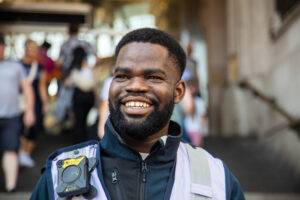 Philip Colligan is executive director of Nesta’s Innovation Lab. He spoke to New Start about embedding innovation within councils and why local government is well-placed to solve today’s challenges
Philip Colligan is executive director of Nesta’s Innovation Lab. He spoke to New Start about embedding innovation within councils and why local government is well-placed to solve today’s challenges
What’s your definition of innovation? Ninety per cent of what’s called innovation is about improving what you’ve got – answering your calls better, delivering public services more efficiently and effectively. But what we’re more interested in is transformative innovation, which is about asking fundamentally different questions rather than asking how do we do something better. Take care homes. Innovation might ask ‘how can we get better care homes at lower cost which serve more people?’. That takes you down a certain path. But the type of innovation we’re more interested in is asking the question ‘what will help older people live better lives?’. This takes you down a route that may not be about care homes but may be about creating networks in communities that allow people to live independently for longer. A better word is experimentation. We support people to try out, learn, watch, effect and adapt.
You run the Creative Councils programme, to support local authorities to be more innovative. What in particular do councils need help with to be more innovative? There is this paternalistic idea that public services are about doing things to people and this is a deeply ingrained culture. It’s not because public servants are bad but just the way their roles have been configured. And there’s a dependency element in the dynamic between public services and citizens so people feel they have to fight for resources from public services and public services feel they have to ration those resources. In Monmouthshire council [one of Nesta’s Creative Councils] they are taking very seriously the idea you have to retrain the staff and have set up an intrepreneurship school within the council. So there’s something about the culture you have to overcome. A huge part of innovative work is about retraining the workforce and shifting the culture.
One of the hard bits is carving out the resources and the headspace to invest in the future. We’re doing research with Bloomberg Philanthropies on approaches to innovation in government around the world. New York, for example, has a Centre for Economic Opportunity. It funds things that are innovative but if they aren’t delivering they shut them down straight away. In the UK we find it hard to do that. At a time when we’re taking money out, it’s difficult to put some money and energy aside to invest in the future and say some of this won’t work. We elect politicians on the basis of them saying ‘I absolutely know the answer. Trust me, this is right’. The whole system mitigates against experimentation.
Nesta’s focus is people-based services and co-production. Can you give some examples? We’ve backed a lot of innovation in the area of health and social care such as Tyze which is an online tool which brings together all the people in the network of someone with care needs. So it could include the local authority, their neighbours, their GP etc, and these people come together and organize the little tasks that enable people to live well independently. It’s been in Canada a few years and has 10,000 users. Local authorities and housing associations are starting to use it here. It’s a great example of public services mobilising people’s networks and families to help them to live well and reduce demand on public services. We also have a big programme called people-powered health which uses peer-to-peer structures to support people with mental health needs to allow them to be discharged them from acute settings sooner. These are about mobilising community resources and assets alongside the professional resources and assets.
What techniques can be used by councils to help them transform services? One of tools we deploy to help public services innovate more effectively is ethnographic research – spending time in communities and listening to them and understanding the day to day reality of their lives. In a Reading children’s centre for example, staff did 90 interviews to listen to what people think of the centre and their concerns in life, including those not using the centre. This was a high-performing award-winning childrens centre and the people who could most benefit from it didn’t use it because they thought they would be stigmatised or judged when they turned up. That whole process led to a set of innovations, called Mums Helping Mums, which is a parent support group that points new mums to services. It gets a small amount of support from the state and solves a problem on the ground.
The traditional model of consultation and engagement sets up a ridiculous dynamic. It’s ‘we’ve proposed something and we invite you to oppose it and we’ll defend it’. I saw in mental health daycare services when I worked at Camden Council. The services were terrible but any attempts to close them saw people march in the streets. We commissioned a new consortium of providers to take a co-produced approach and Camden mental health day services have been transformed. Instead of day centres where people argue over the remote control there are cafes and businesses run by people with mental health problems. If you’re a clinician looking to refer someone you send them to the time bank at Holy Cross and the first question is ‘what can you do, what are your aspirations what are your hopes, what can you contribute?’. It’s that kind of shift.
What can local authorities do to fund innovation? Local authorities are using own resources more creatively. They don’t need to go outside to find the resources you’d find in a social impact bond, for example. One of the things we talk to local authorities about is making sure you have right type of finance for the stage of innovation. If it’s really early stage development they need small amounts of grant finance and trying to bring in different types of funding is too difficult. There’s lots of interesting things around crowdfunding, which can combine public resources with that of citizens. A local authority could say, ‘we’ll back up to this stage’, but you have to raise the rest from the community. We’ve had the People’s Port in Dover where citizens can subscribe and become owners of it. That’s how mosques were built – families would buy bricks – and the plinth on the Statue of Liberty was funded by local subscription. It’s a very old idea and it’s not about replacing public funds but about other types of funding becoming a bigger part.
How can councils and local business work and innovate together? If you speak to the leaders of places like Wigan and Rotherham they are very focused on partnerships with business and civil society. Rotherham wants to be an enterprise city, and have a programme called Rotherham Ready to engage young people in schools. Stoke has a vision to be energy self sufficient by 2030. The last time a local authority set out something like that was probably in 1890s when you had industrialists going into local government. Stoke has incredible vision. They’ve struck a deal with a local energy company and set up a joint venture vehicle. It’s a real risk, really tough, in an authority where partnerships with the private sector are controversial. But they’ve done it. They chose this as a strategy to enable the local pottery industry to survive. The biggest risk to the industry is rising energy prices so they came at it in order to keep jobs in area. Those kinds of partnerships are rare examples of local government really getting on front foot.
What’s the secret to success in local government innovation? It’s about assets. Each place has amazing things about it that are often underutilised. Local government is very well placed to figure out what it is that’s special about a place and use that to elevate the ambitions of people. Local government needs to be more open – have more open systems and use technology and data – but for the kind of challenges we face local government is well placed to solve them. There’s also a whole range of organisations – FutureGov, MySociety, Participle – who are working in collaboration with public institutions. The best innovations come when you combine different kinds of knowledge. I’m optimistic but local government needs to be more open to those kind of collaborations and it needs to be a bit more bold. We need a bit more of the civic entrepreneurialism that gave us the great assets we have.
Those who moved to public service in the 1800s – through ego or wanting to do right thing – they had ambition. That’s the difference. What unites the innovative councils of today is that they have incredibly bold ambition about what local government can do and they are very skilled about making it happen. There isn’t enough positivity and optimism about local government. We need to try to elevate those doing genuinely good work. It needs to up its game significantly when it comes to innovation and we need more experimentation.

















Leave a Reply